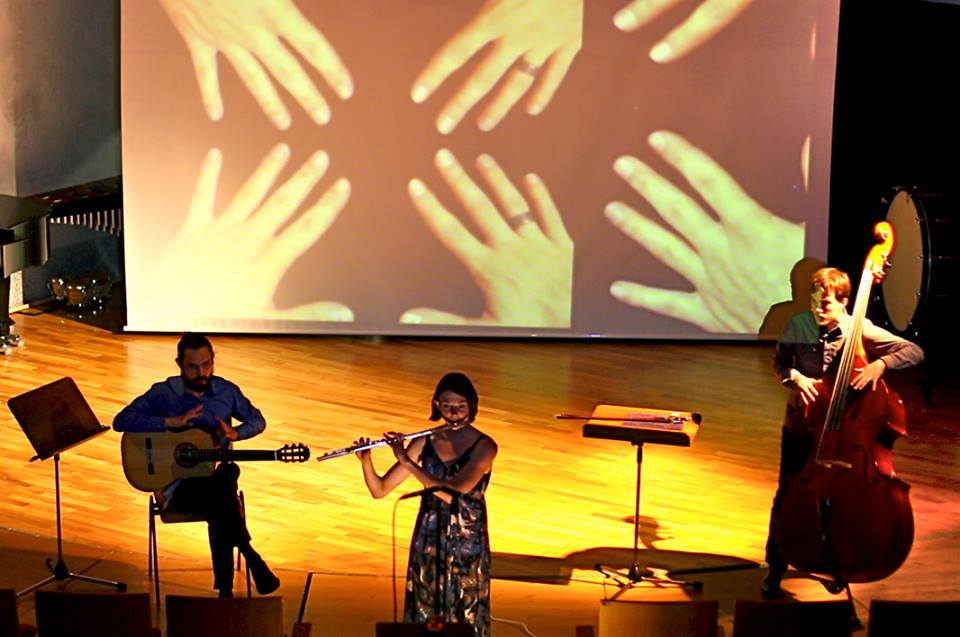It has now been a month since the SoundSCAPE Festival 2014, but I have been mulling over this post for a while and am keen to put it up. The whole festival experience was great: I came across several really stunning pieces and performances, and had the opportunity to work with many truly wonderful artists. However, among all this one piece really stood out for me, both in the rehearsal process and final performance.
The work was Third Person by New Zealand composer Celeste Oram, and for me was one of those rare pieces that pushes one’s musical boundaries in a really substantial way. I received the work via email to find that it was not a written ‘score’ in the conventional sense but rather an 8-min long video and a page of instructions. For flute, guitar and double bass, the video was arranged as three panels on the screen, with one panel my part of the score to read. My fellow performers were guitarist Jeremy Bass and double bassist Matt Kline.
On the outset the instructions were simple: copy the physical actions depicted on the screen as closely as possible, creating sounds which then accompany the video performance. In particular, it was noted that “the performers’ priority should always be to embody the quality of the onscreen figures’ movement: never to imitate its anticipated resultant sound, or to painstakingly decipher the pitch material being played.” We were encouraged to “consider how these mirrored movements can offer interested and varied sonic results”, to “err both on the side of playing instruments unconventionally and flamboyantly – engaging the whole body – and on the side of producing sounds which seem unexpectedly at odds with the visual image.” My part differed a little from that of the guitar and double bass in that it was for the most part videos of people playing flute. There were a couple of shots of hands, either tapping or typing, but mostly I was faced with flute players doing more-or-less fluty things. The guitar/bass combo, by contrast, got to mimic saws, razors, guns and archery, not to mention more varied forms of their own instrument (think bowed electric guitars and small children playing violins like cellos).
Before arriving at SoundSCAPE, I practised the piece to some extent, trying to ‘learn’ the score a little and play with some of the sounds I could produce. However, on arriving at the festival, I realised that it was much more difficult to realise Celeste’s vision than I had originally thought. Our first rehearsal felt good at the time, but was not tight, more improvised than the intended ‘reading’ of the score. Furthermore, I always started from the flute sounds and when in doubt, erred on the side of the conventional. As flautists, we learn not to breathe loudly, and so I didn’t. We spend hours and hours learning to produce a beautiful, pure sound, so that’s what I initially tried to do. Yet Celeste’s concept for the piece was very different, and through the course of our rehearsals she pushed us to look more and more closely at the fine details of her meticulously-produced score.
Over the course of our rehearsals, the fascination became the details. Far from wanting me to breathe like a nice classically-trained flautist, Celeste had deliberately chosen videos with unusual or just downright bizarre breathing. Then she put those segments on loop! One particular snippet – of a woman breathing in with a very open mouth – was looped so that I was mimicking about fifteen quick in-breaths in rapid succession with no flute sound and no chance to breathe out. Finally, when I arrive at a gasping pant that sounded like I know not what and left me feeling rather dizzy, was I pronounced to be “on the right track”. Celeste also pushed me to look for when the performer closed their eyes, at their body posture and the angle of their flute. If anything, she wanted airy, bizarre sounds, especially if it could be a reflection of their embouchure.
This sort of piece relies so much on the collaborative energy of the composer and performers, and it is because of this that it will stick so clearly in my mind. Jeremy and Matt were always prepared to make new sounds and push the boundaries musically. Nothing was ever beneath them, and indeed there were several moments where everyone in the room could only nod in the agreement that “that was cool”. Celeste asked that we be creative and daring, and I feel that the cumulative energy of this in our rehearsals turned a cool idea into a really fascinating performance. Her music, as well as her compositional attitude, demanded nothing short of 100%, and 300% was getting near optimal. Increasingly, I left our rehearsals exhausted, and after the performance was utterly so.
(I must also at this point confess to having spat a bit into the first few, thankfully empty, rows of the auditorium due to the violence with which I ultimately attempted to imitate one of the flautists.)
In our early rehearsals, I thought (rather self-importantly maybe?) that the ‘third person’ of the work’s title was the flautist, who seems to be ganged-up on by the other two and eventually shot down by them. Celeste never got round to sharing that particular piece of inspiration. In retrospect, I wonder whether the ‘third person’ applied to each performer individually in their own way. There’s a first person in the self as is, and a second in the self as a performer. Finally, there is a third person, one that appears only occasionally when we take a leap of musical and artistic faith.

